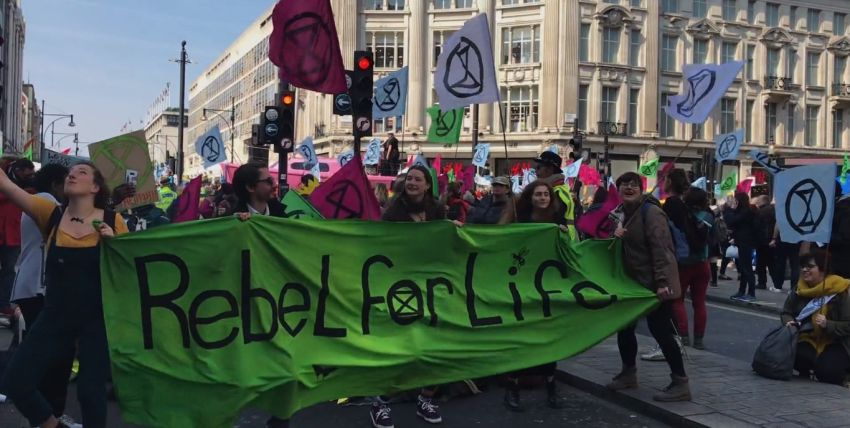
Conscientious Protectors: A Story of Rebellion Against Extinction
Directed by Leigh Bloomfield
In cinemas and available through Demand Film
Climate change is with us. Emissions and temperatures are ever increasing and, while no single fire or flood can be blamed on global warming, hardly a day goes by without an extreme weather event occurring.
Governments do little and corporations are committed to profit whatever the pollution. So how can we turn despair and anger into resistance?
This is the question asked by director Leigh Bloomfield in Conscientious Protectors: A Story of Rebellion Against Extinction, a documentary about the April 2019 Extinction Rebellion (XR) uprising that shut down much of central London. It is a fly-on-the-wall, reality TV-style narrative of the inspiration for the action, the months of preparation and the 10 days of occupation.
It is exhilarating and frustrating to watch.
The exhilaration is because, in a certain sense, it was a triumph. Despite over 1000 arrests being made, to non-violently capture a major capital city is very impressive.
XR grew from an original group of 15 people in 2018 to a mass movement drawing tens of thousands and costing, for this action alone, about £20 million to police. It is exciting to watch the idea for the bold action move from an apparently unrealistic dream to reality.
The film opens with XR founders Roger Hallam and Gail Bradbrook.
Hallam leads the film crew around his farm in western Wales, where he observes that climate change is leading to storms that threaten his polytunnel greenhouses and make his business impossible. Bradbrook, long-term activist and NGO organiser, argues that only massive nonviolent direct action will work to alert society to the threat of extreme weather conditions.
We are taken through initial XR organising meetings and members are filmed scoping out Waterloo Bridge in London determining how they can occupy it and stop traffic.
The film shows tens of thousands of XR supporters stream into London in April 2019 and occupy key positions, including Parliament Square, Oxford Circus and Marble Arch. A vibrant protest community sets up tents and stages; speeches are made and songs are sung.
The rebellion is in full swing and there is apparently nothing the authorities can do.
Bloomfield catalogues all this in fascinating detail.
Is this what victory looks like? I am not quite sure.
Hallam, Bradbrook and their comrades successfully mobilised huge numbers of people. They did so by thinking strategically and learning lessons from previous activism.
XR have been criticised in numerous ways, but how many people did their critics mobilise?
They had a victory, but maybe they won by mistake — Hallam’s strategic thinking at the time was one of regime change.
His theory is: in response to an unjust government, people will eventually take to the streets, nonviolence will win over the police and the army and the regime will topple. Dramatic direct action gets attention, polarises people and builds numbers until the rebellion is irresistible.
XR activists in the film talk about the protest becoming “non linear” — the movement taking on a life of its own out of their control. They theorise that if the occupations continued for two weeks the authorities would be in an impossible position.
Hallam argues that if enough arrests are made, the legal and policing system would be so clogged up that it would cease to function. There are three problems with this.
First, climate change isn’t as simple as regime change. While some governments are better than others on ecological matters, climate change is more systemic and deeply rooted in capitalism than in a particular administration.
Any serious social change could be termed as a kind of permanent revolution. Long term, patient institutional work is needed too.
Second, and most fundamentally, the regime didn’t fall. Britain still has a right-wing Tory government.
Third, the schoolish strategic assumptions around policing leave a sour taste. Their aim is to use nonviolence and dialogue to win over the cops.
However, the constant interchange and negotiations shown throughout the film makes one wonder if the cops are actually winning over the protesters, rather than the other way round.
In the end, the film shows XR activists meeting with the British government and the mayor of London. The mayor, unlike the government, lets the film crew in.
As a result, no toppling, but some success in forcing awareness of the urgency of climate action. A rebellion that wins a little reform is better than one that fails to gain any attention.
Conscientious Protectors is an interesting film about an exciting movement. But XR’s subsequent story, where it has become more anti-capitalist and more militant, spawning blockades of Murdoch newspaper print works, oil refineries, fossil fuel-funding banks and other precise targets, would make a messier but better film.
[Derek Wall is a former International Coordinator for the Green Party of England and Wales. His latest book Climate Strike: The Practical Politics of Climate Crisis is available from Merlin Press.]